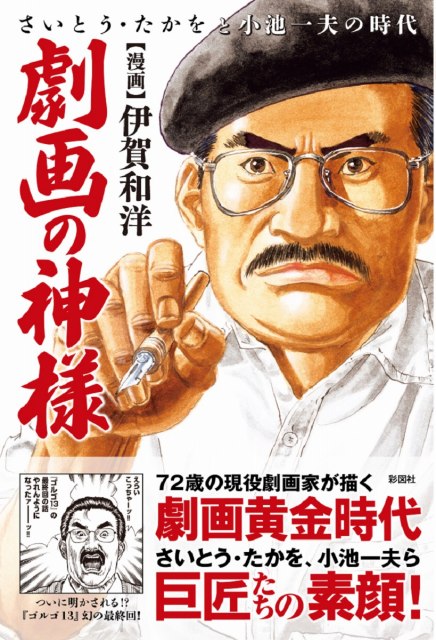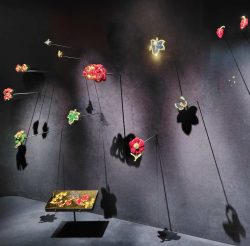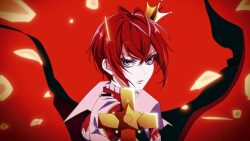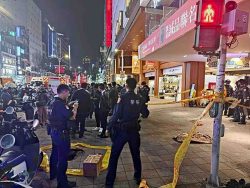- Manga & Anime
- KANTA ON MANGA
Documentary-Style, Autobiographical Manga Remembers 2 Gekiga Gods of the 1970s; Iga Depicts Fierce Competition Between Saito, Koike

The cover of “Gekiga no Kamisama” by Kazuhiro Iga
Gekiga no Kamisama (The gods of gekiga)
by Kazuhiro Iga (Saizusha)

12:00 JST, June 21, 2024
The late Takao Saito, the author and artist of “Golgo 13,” told people he had decided exactly how he would end the popular hard-boiled manga, but he never told anyone what that would actually look like. The famous gekiga — a type of manga for adults, which became popular in the late 20th century — continues to be published but is now drawn by Saito’s staff.
This month’s manga, “Gekiga no Kamisama” (The gods of gekiga), has a scene that refers to this exact situation.
In this documentary-style manga, Saito reveals the final chapter of “Golgo 13” to his staff and tells them that Golgo, the main character and hero of the story, is stabbed by a mere thief and quickly dies. This is indeed unexpected.
Saito is quite confident about his unique and clever idea, but one day, he sees his “perfect” ending for Golgo used on a detective show on TV.
“Oh, no!” he exclaims. Saito then mutters, “I have to come up with an even more unheard-of way for Golgo to die.”
This episode has to be true, as the author, Kazuhiro Iga, witnessed it himself.
Iga joined Saito Production in 1970 after graduating from high school and became Saito’s assistant. Iga is still actively drawing gekiga at 72. Known for his realistic and impactful drawing style, he has worked on samurai and historical manga, such as “Shogun no Bodyguard” (The shogun’s bodyguard). “Gekiga no Kamisama” is his latest work, which is autobiographical and vividly portrays the golden age of gekiga in the 1970s.
Another god in the industry who appears in this work is the late Kazuo Koike, who is the storywriter for many gekiga series, including “Kozure Okami” (“Lone Wolf and Cub”). Koike was originally a part of the story-writing staff at Saito Production and was involved in the launch of “Golgo 13.” Koike left after a few years and set up his own studio.
In 1972, Iga left Saito Production to join Koike. In other words, Iga worked very closely with two charismatic legends in the gekiga world. The contrast between the two titans is endlessly fascinating.
Saito was one of the pioneers in introducing a division-of-labor system to create manga, but he failed to mentor anyone who could surpass him. Koike, on the other hand, envisioned developing a group of artists who are given more freedom to improve each of their own strengths. To realize his vision and also promote his “character theory,” which was his belief that developing attractive characters was the most important element of any manga, Koike opened a private gekiga school.
Although both Saito and Koike worked to organize and commercialize manga production, the methods they utilized were very different. In “Gekiga no Kamisama,” Iga candidly depicts the fierce competition that existed between the two gods of the industry.
Koike died in 2019 and Saito in 2021. While it is meaningless to think about who won, the obituaries of Koike, who experienced business failures and copyright issues later in life, were shorter than those written about Saito. Personally, I feel that Koike’s achievements in producing many unique works and nurturing a number of outstanding manga artists deserve more praise and should be reevaluated.
“Golgo 13” became an animated film in 1983. Just before the movie ends, there is a scene in which a woman suddenly shoots Golgo. The woman became a sex worker after Golgo shot her husband, but he has no idea who she is. The movie ends without clearly showing whether the bullets hit Golgo or not.
I am only speculating, but that scene might have been Saito’s new idea to end the series. I mentioned in the beginning that the series continues to this day. I can’t help but wonder whether Saito’s staff is thinking of a new way to end the manga series by killing the hero in an even more unheard-of way.
"Culture" POPULAR ARTICLE
-

Van Cleef & Arpels Dazzles with Art Deco Artisanry at Tokyo Exhibit
-

Disney’s ‘Twisted-Wonderland’ Animated Series Puts Villains in Spotlight: New Show Features School Inspired by Classic Disney Films
-

Japan Plans to Distribute Manga Overseas Via New Platform
-

Japanese Craftsman Produces Beautiful and Durable Bags Made of Wood
-

Ayumi Hamasaki’s Shanghai Concert Canceled Day Before Schedule as Part of Beijing Backlash
JN ACCESS RANKING
-

Keidanren Chairman Yoshinobu Tsutsui Visits Kashiwazaki-Kariwa Nuclear Power Plant; Inspects New Emergency Safety System
-

Imports of Rare Earths from China Facing Delays, May Be Caused by Deterioration of Japan-China Relations
-

University of Tokyo Professor Discusses Japanese Economic Security in Interview Ahead of Forum
-

Japan Pulls out of Vietnam Nuclear Project, Complicating Hanoi’s Power Plans
-

Govt Aims to Expand NISA Program Lineup, Abolish Age Restriction




◎上海の日本アニメイベント_20251129YGTGS000921_C-250x168.jpg)



















